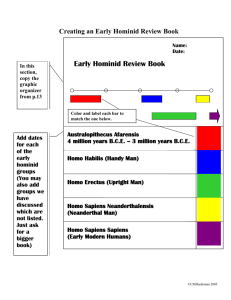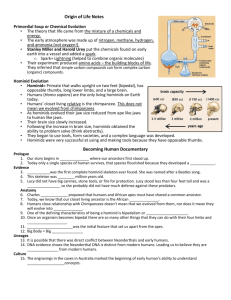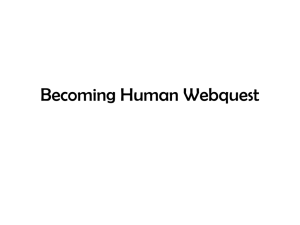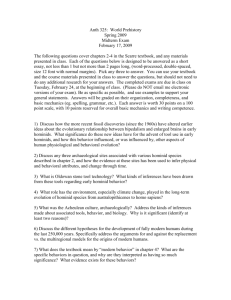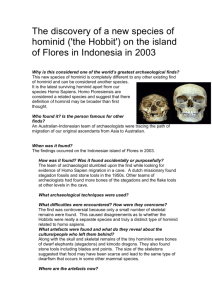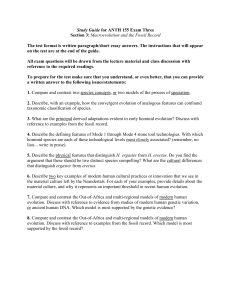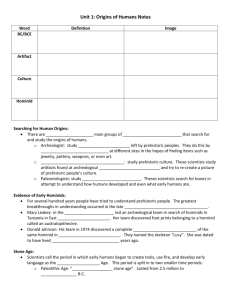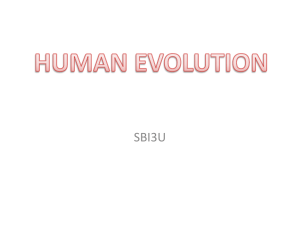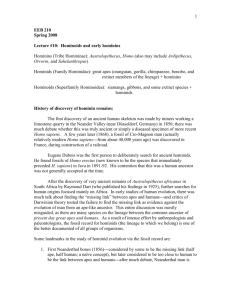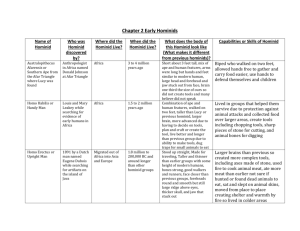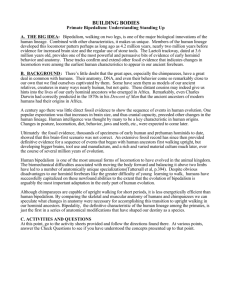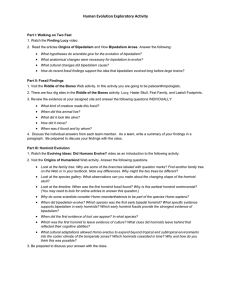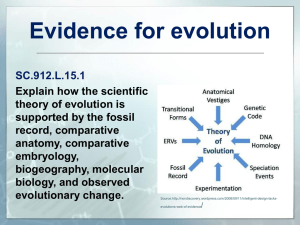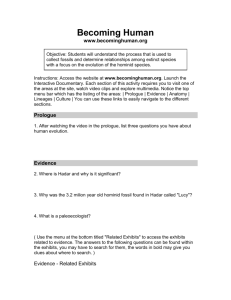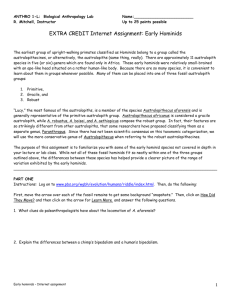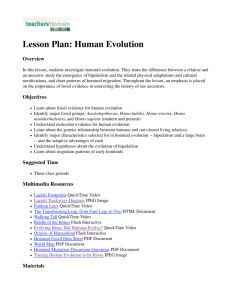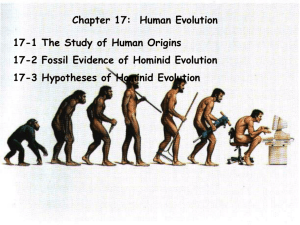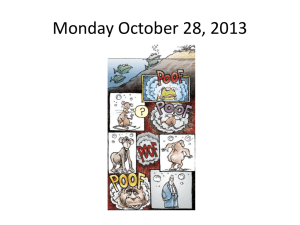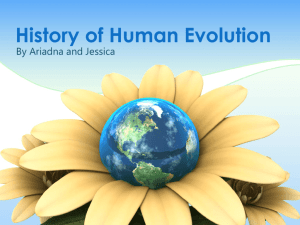More evolution Questions.doc
advertisement
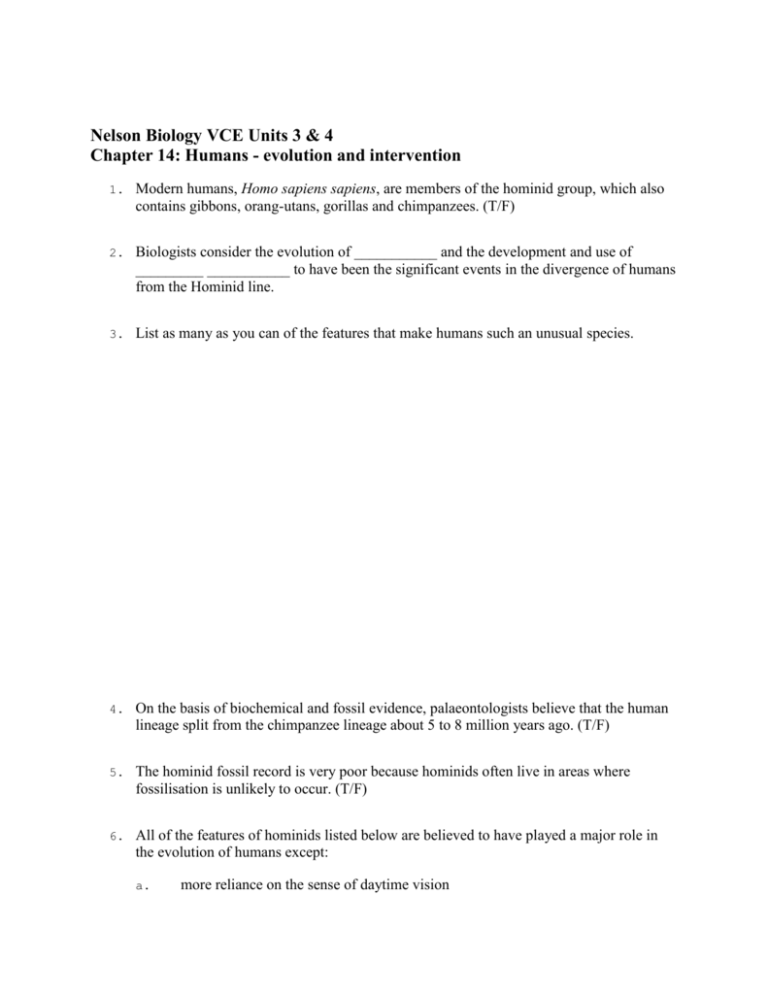
Nelson Biology VCE Units 3 & 4
Chapter 14: Humans - evolution and intervention
1.
Modern humans, Homo sapiens sapiens, are members of the hominid group, which also
contains gibbons, orang-utans, gorillas and chimpanzees. (T/F)
2.
Biologists consider the evolution of ___________ and the development and use of
_________ ___________ to have been the significant events in the divergence of humans
from the Hominid line.
3.
List as many as you can of the features that make humans such an unusual species.
4.
On the basis of biochemical and fossil evidence, palaeontologists believe that the human
lineage split from the chimpanzee lineage about 5 to 8 million years ago. (T/F)
5.
The hominid fossil record is very poor because hominids often live in areas where
fossilisation is unlikely to occur. (T/F)
6.
All of the features of hominids listed below are believed to have played a major role in
the evolution of humans except:
a.
more reliance on the sense of daytime vision
b.
c.
d.
skeletal changes associated with upright walking
muscular and skeletal changes associated with hand movements
specialisation of teeth for particular diets
7.
Although many biologists believe humans evolved in the savannah grasslands of Africa,
some believe that humans evolved as semi-aquatic animals. (T/F)
8.
Many biologists would argue that the evolution of excellent dexterity of the human hand
was only possible because of the associated development of ___________ motion.
9.
The development of speech in humans, controlled by complex neural mechanisms,
resulted in a significant increase in ___________ function.
10.
It appears that the first hominoids (human-like apes) lived in Eastern Africa during the
Miocene period but significant hominoid extinction occurred about 13 million years ago
because of climactic change. (T/F)
11.
Australopithecus africanus, fossils of which were found by Raymond Dart in 1924, is
considered to be an early human ancestor because fossil evidence indicated that:
a.
b.
c.
d.
the organism walked erect
the organism had human-like teeth
its brain size was typical of humans
the organism had human-like hands
12.
Paleoanthropology is the study of _______ _____________ through fossil evidence.
13.
Because of the evidence of fossils such as 'Lucy', biologists have now established one
clear pathway for human evolution. (T/F)
14.
Try to match each hominid with the dating information provided:
a.
b.
c.
d.
a.
b.
c.
d.
Lived about 3 million years ago
Lived about 2 million years ago
Evolved about 1.5 million years ago,
migrated to Asia
Largest hominid brain
1.
2.
3.
4.
Homo sapiens
Australopithecus afarensis ('Lucy')
Homo erectus
Homo habilis
15.
A group of organisms of common ancestry with distinguishing physical characteristics is
called a _______. These groups belong to the same species because they are capable of
interbreeding.
16.
Species sometimes have distinctive groups called morphs, which have different forms.
Morphs differ at a number of gene loci, and interbreeding, although possible, is rare.
(T/F)
17.
Comparisons of human proteins and DNA, combined with available fossil evidence,
suggest that modern humans evolved most recently from the _____________ lineage.
The available evidence suggests that protein evolution in hominids has been a remarkably
regular process.
18.
Through the process of artificial selection (selective breeding), humans have been
altering the ______ ______ of particular species that have been domesticated for a very
long time.
19.
Medical scientists are now using genetic diagnostic tools to detect genes for inherited
diseases in foetuses and even adults. We would expect that this process will have no
effect on gene frequency in the human population. (T/F)
20.
Elimination of a disease gene from the human gene pool may have unpredictable effects
for the human population. (T/F)
21.
The domestic dog is the animal species that has been subject to human artificial selection
for the longest period. A consequence of this selective breeding by humans is that many
modern pedigree breeds are inbred and unhealthy. Some species can no longer reproduce
without human intervention. (T/F)
22.
The theory of evolution is a ___________ theory, and as such it can be tested. The theory
allows us to make predictions about the kinds of fossil evidence we should be able to find
in particular areas.
23.
Scientists generally accept the modern theories of evolution and natural selection,
however, some aspects of the history of life on Earth are difficult to explain fully.
Identify some of the scientific questions relevant to the theory of evolution for which
evidence is difficult to find.
24.
Some people have argued that gorillas and chimpanzees have the same rights as people.
(T/F)
25.
Many scientists argue that it is the development of a complex _________ ___________
and associated moral and ethical thought processes that sets humans apart from the other
apes.


